KNEC KCSE Past Papers Agriculture 2014
KCSE Past Papers Agriculture 2014
3.15.1 Agriculture Paper 1 (443/1)
SECTION A (30 marks)
Answer all the questions in the spaces provided.
1 State four advantages of organic farming.(2 marks)
2 Give four factors that can increase seed rates in crop production.(2 marks)
3 State four roles of organic matter in sandy soils.(2 marks)
4 Give four reasons for practicing minimum tillage.(2 marks)
5 What is meant by each of the following in crop production?
(a) Crop rotation;(1 mark)
(b) Mulching.(1 mark)
6 Give four reasons for inverting soil slices during primary cultivation.(2 marks)
7 State four cultural Ways of controlling couch grass (Digitaria scalarum).(2 marks)
8 (a) Name three vegetative parts that can be used to propagate pineapples.(1½ marks)
(b) State three disadvantages of vegetatively propagating pineapples.(1½ marks)
9 Name three sources of underground water.(1½ marks)
10 What is meant by each of the following in agroforestry?
(a) Pollarding;(1 mark)
(b) Coppicing;(1 mark)
(c) Lopping.(1 mark)
11 State the information included in a sales receipt when a farmer is selling eggs.(2½ mark
12 State two reasons for practising agroforestry on a
(a) river-bank;
(b) steep slope.(1 mark)
13 State three disadvantages of using plastic pipes to convey water. (1½ marks)
14 State three causes of blossom end rot in tomatoes. (1½ marks)
15 What is meant by the term preference and choice as used in agricultural economics? (1 mark)
SECTION B (20 marks)
Answer all the questions in the spaces provided.
16 (a) Distinguish between straight and compound fertilisers. (1 mark)
(b) A farmer applied 200 kg of CAN (20%N) per hectare on his five hectares maize crop.
Calculate the amount of nitrogen the farmer applied on his crop. Show your working.
(4 marks)
17 The diagram below illustrates a type of soil erosion.
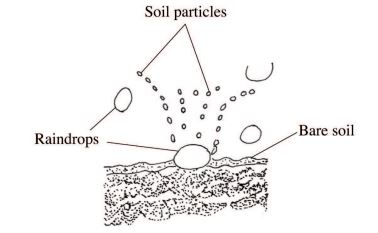
(a) Identify the type of erosion. (1 mark)
(b) How does the type of erosion shown above occur? (2 marks)
(c) How does cover cropping help to control the type of erosion shown above? (2 marks)
18 The table below shows the population and gross domestic products of countries A and B.

(a) Calculate the per capita income for each country. Show your working. (2 marks)
(b) Which of the two countries is more developed economically? (1 mark)
(c) Give a reason for your answer in (b) above. (1 mark)
(d) How can agriculture increase the gross domestic product of a country? (1 mark)
19 The photograph below shows weeds labelled A and B.
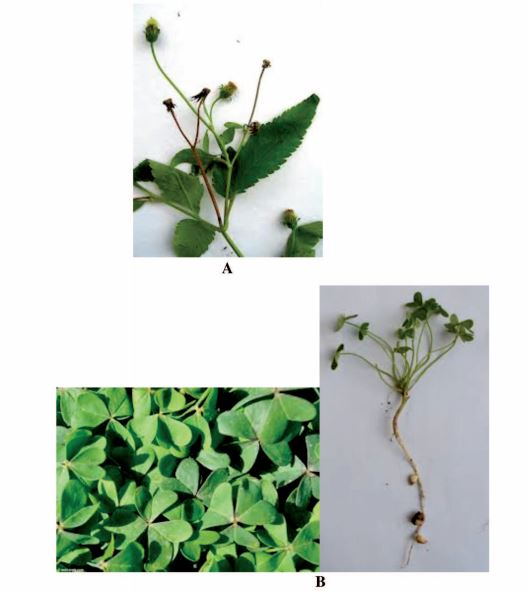
(a) Identify the weed labelled A. (1 mark)
A …………………………………………… ..
(b) State one mechanical control measure for the weed labelled A. (1 mark)
(c) Which category of herbicide will he most suitable to control the weeds labelled A and B?
A ……………………………………………(1 mark)
B ………………………………………………..(1 mark)
(d) Give a reason for your answer on weed B in (c) above.(1 mark)
Section C (40 marks)
Answer any two questions from this section in the spaces provided after question 22.
20 (a) Describe the various risks and uncertainties in crop farming.(10 marks)
(b) State the functions of Young Farmers Clubs in Kenya.(5 marks)
(c) Give the reasons for land registration in Kenya.(5 marks)
21 (a) Explain five ways in Which the Kenyan government can improve maize production to ensure food security in the country.(10 marks)
(b) Why is pruning done in crop production?(10 marks)
22 (a) The tables below give information on the supply and demand schedules for tomatoes on a market.
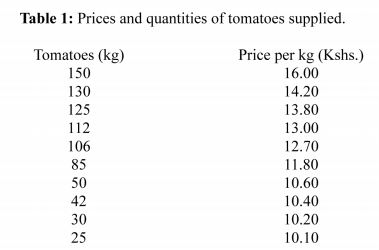
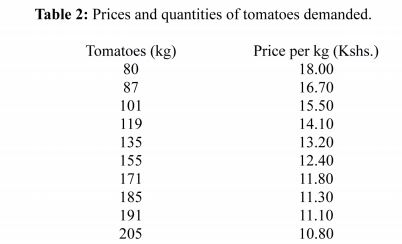
(i) Using the above data, plot supply and demand curves on the same axes. The axes have been labelled for you. (7 marks)
(ii) Determine the price at which 120 kg of tomatoes were supplied on the market. (1 mark)
(iii) How many kilograms of tomatoes were bought at a market price of Ksh. 13.00? (1 mark)
(iv) What was the equilibrium price for tomatoes on the market? (1 mark)
(b) Describe the production of maize under the following sub-headings:
(i) seedbed preparation; (4 marks)
(ii) planting; (3 marks)
(iii) harvesting. (3 marks)
3.15.2 Agriculture Paper 2 (443/2)
SECTION A (30 marks)
Answer all the questions in this section in the spaces provided.
1 Name the two products obtained from dual purpose sheep.(1 mark)
2 Give two practices that should be done to a newly born calf with difficult breathing.(1 mark)
3 (a) What is meant by the term two host tick?(1 mark)
(b) Give two examples of two host ticks in cattle.(1 mark)
4 State four disadvantages of using plunge dips in tick control.(2 marks)
5 (a) State the functions of the following farm tools and equipment:
(i) pipe cutter;(½ mark)
(ii) wire strainer.(½ mark)
(b) Name four tools that can be used to assemble a jembe.(2 marks)
(c) Name the complementary tool for each of the tools named below:
(i) trochar:(½ mark)
(ii) hand drill.(½ mark)
6 Name two livestock diseases controlled through embryo transplant.(1 mark)
7 State three factors that limit external parasite control in Kenya.(1 ½ marks)
8 State four characteristics of the Duroc Jersey pig.(2 marks)
9 Name four categories of poultry feeds according to the stages of growth of birds. (2 marks)
10 State four ways in which a vaccine can be administered to livestock.(2 marks)
11 (a) Name three protozoan diseases of cattle.(1½ marks)
(b) State four symptoms of rinderpest in cattle.(2 marks)
12 State four maintenance practices carried out on a spray race.(2 marks)
13 (a) Give four reasons for proper feeding in livestock rearing.(2 marks)
(b) State four good hygiene practices in livestock feeding.(2 marks)
14 State four reasons why kids should be weighed immediately after birth.(2 marks)
SECTION B (20 marks)
Answer all the questions in this section in the spaces provided.
15 The picture below shows a poultry farm structure.
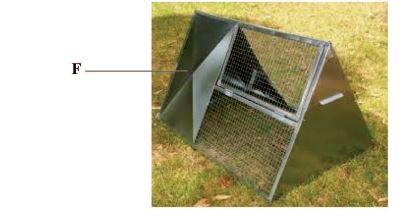
(a) Identify the farm structure.(1 mark)
(b) Apart from metal, name two materials that can be used for the part labelled F. (2 marks)
(c) State three disadvantages of using the farm structure illustrated above in poultry rearing.(3 marks)
16 The picture below illustrates a livestock organ infested by a parasite labelled E.
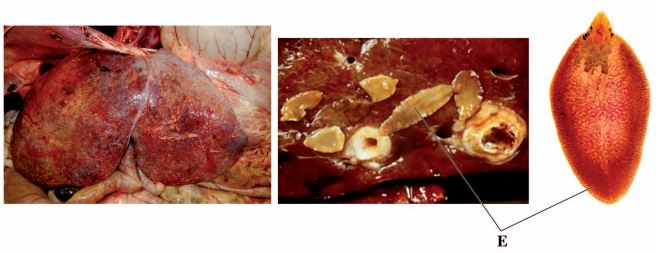
(a) Name the disease the livestock is suffering from. (1 mark)
(b) Identify the parasite labelled E. (1 mark)
(c) State two control measures for the parasite. (2 marks)
(d) State two signs of infestation shown in the picture above. (2 marks)
17 The pictures below illustrate two rabbit breeds.
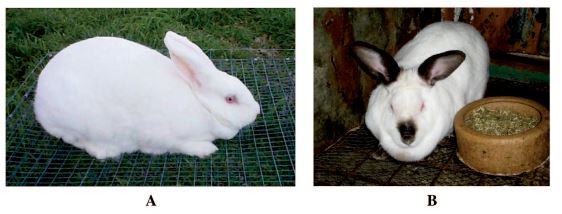
(a) Name the rabbit breeds shown above.
A ……………………………………………………… .. (1 mark)
B……………………………………………………. .. (1 mark)
(b) Name the major feeding practice missing from the photograph labelled B. (1 mark)
(c) Give one advantage of housing the rabbits on the floor illustrated above. (1 mark)
18 The following is an illustration of a chick suffering from malnutrition.
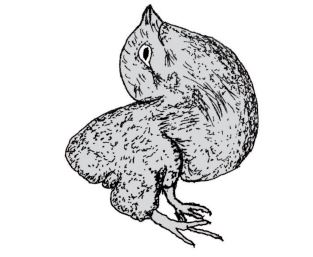
(a) Identify the mineral deficiency shown by the chick (1 mark)
(b) Apart from the symptom illustrated above, give three other symptoms of mineral deficiency in poultry.(3 marks)
SECTION C (40 marks)
Answer any two questions from this section in the spaces provided after question 21.
(b) Describe the causes of low egg production in layers.(8 marks)
19 (a) Describe upgrading as a method of improving indigenous cattle for milk production. (12 marks)
20 (a) Describe how the late weaning programme is conducted in a dairy calf. (12 marks)
(b) Describe how a newly constructed pond is prepared and stocked with fingerlings.(8 marks)
21 (a) (i) Describe short-term tractor servicing.(10 marks)
(ii) Explain the maintenance practices that should be carried out on an ox-cart. (5 marks)
(b) State five indicators that can be observed on a goat to confirm sickness. (5 marks)
KCSE Past Papers Agriculture 2014
4.15.1 Agriculture Paper 1 (443/1)
SECTION A (30 marks)
1.(i)Products are free from chemical residues;
(ii) It is environmentally friendly;
(iii) Livestock and farmer do not risk effects of poisonous chemicals;
(iv) Ozone layer is preserved;
(v) It uses locally available materials/cheap;
(vi) It maintains soil structure;
(vii) Promotes microbial activities in the soil.
(2 marks)4x ½
2. (i) Seed impurity;
(ii) Low germination percentage;
(iii) Close spacing;
(iv) More seeds per hole / broadcasting;
(v) Early planting / dry planting;
(2 marks)
3. (i) It improves soil capillarity;
(ii) It improves soil water holding capacity;
(iii) It binds soil particles/improves soil structure;
(iv) It improves soil microbial activities;
(v) Modifies soil temperature;
(vi) It provides nutrients on decomposition;
(vii) It buffers soil pH.
(2 marks)4x½
4. (i) It conserves soil moisture;
(ii) It maintains soil structure;
(iii)It saves costs on land preparation/saves on time/saves on labour;
(v) It ensures minimum disturbance to plant roots;
(vi) Control soil erosion;
(vii) Reduces soil compaction by tillage implements;
(viii) Prevents loss of nutrients by volatilization.
(2 marks)
5. (a) Is the growing of crops of different families on the same piece of land in an orderly sequence; (1 mark)
(b) Is the covering of the ground around a growing crop With organic matter or artificial sheets; (1 mark)
6. (i) To burry organic matter/weeds into the soil;
(ii) To expose soil to agents of weathering;
(ii) To expose pest/disease agents to predators/strong sun;
(iii) Bring up leached plant nutrients to the surface;
(iv) To encourage Water infiltration/aeration.4 X ½
7. (i) Mulching;
(ii) Cover cropping;
(iii) Crop rotation;
(iv) Timely planting;
(v) Proper spacing;
(v) Flooding;
(vi) Clean seedbed;
8. (a) (i) Crowns;
(ii) Suckers;
(iii) Slips;
3 x ½
(b) (i) Transmits diseases;
(ii) Propagates genetic/varietal defects;
(iii) No uniformity in growth;
(iv) It is laborious/bulky;
(v) Vegetative materials cannot be sored for long.
3 X ½
9. (i)Springs;
(ii)Bore hole;
(iii)Wells;
3 X ½
10. (a) Pollarding – cutting back the crown and the top branches of a tree;
(b) Coppicing – cutting down trees about half a meter from the ground;
(c) Lopping – cutting one or more branches from the stem;
11. (i)Date;
(ii) Quantity of eggs;
(iii) Price;
(iv) Amount/total;
(v) Buyer’s name;
(vi) Name of the farm/farmer;
(vii) Signature;
(viii)Serial number;
(iX) Mode of payment (cheque/cash/in kind);
5 x 1/2
12. (a)(i) Stabilize river bank/control river bank erosion;
(ii) Slow down speed of surface runoff;
(iii) Trap soil/debris in surface runoff;
(iv) Reduces risk of flooding;
2 X 1/2
(b) (i) Reduce speed of runoff;
(ii) Trap soil in erosive water;
(iii) Tree roots bind and stabilize the soil/maintains soil structure;
2×1/2
13. (i) Can be gnawed by rodents;
(ii) Become brittle on exposure to strong sun;
(iii) Can burst at high pressure;
14. (i) Irregular watering;
(ii) Lack of calcium;
(iii) Excessive nitrogen application;
3 x ½
15. It is the act of deciding on how to allocate available scarce resources to alleviate uses based on the farmers interests.
SECTION B (20 marks)
16. (a)Straight fertilizer supply only one of the fertilizer element eg N, P or K while compound fertilizers supply two or the three fertilizer elements;(1 mark)
(b)

17. (a) Splash erosion/rain drop erosion;(1 mark)
(b) Soil is detached; by the impact of raindrops;(2 marks)
(c) (i) Reduces impact of raindrops;
(ii) Prevents movement of soil;
(iii) Plant roots bind soil particles;(2 marks)
18. (a) (i)
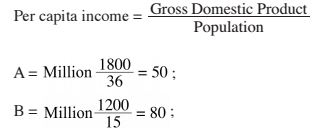
(ii) B;
(iii) B has a higher per capita income;
(iv) By creating employment/developing industries/increasing production;
19.(a)Black jack (Bidens pilosa);(1 mark)
(b)(i) Uprooting;
(ii) Slashing/mowing;
(iii) Cultivation;(1 mark)
(c)A Contact herbicide;
B Systemic herbicide/translocated;(2 mark)
(d) Has underground propagation structures;(1 mark)
SECTION C
20. (a)~ Technology uncertainty.
‘ Price uncertainty.
‘ Personal injury or sickness.
‘ Government policy.
‘ Demand for a commodity uncertainty.
‘ Yield uncertainty.
‘ Theft of crop.
– Fire risk.
‘ Political instability.
‘ Labour uncertainty.
‘ Natural catastrophes.
‘ Pests and diseases.
° Obsolescence.(10 marks)
(b)~ Participating in exhibitions and competitions at ASK shows.
‘ Involvement in agricultural projects at club level.
‘ Participating in YFC annual rallies.
‘ Involvement in workshops & seminar related to agriculture.
‘ Participating in national tree planting activities.
‘ Participation in exchange programmes.
‘ Participating in national ploughing contests.(5 marks)
(c)’ Registered land can be used to secure credit facilities.
‘ Registration minimises land disputes.
‘ Security of tenure encourages long term investment projects/ensures investment on land.
‘ Enables occupant to lease or sell part of the land.
‘ Encourages underlying of soil conservation measures.(5 marks)
21. (a) (i)Farmers training eg. in FTCs on improved methods of maize production.
(ii) Provision of extension services to advise farmers on modern maize production techniques eg. irrigation, use of certified, irrigation, pest and disease control to reduce cost of production.
(iii) Provision of subsidies on farm inputs eg. fertilizers.
(iv) Provision of credit facilities eg. through AFC, to finance maize farming operations.
(v) Imposing high taxation on imported wheat and maize products to discourage importation and protect local farmers.
(vi) Quality control to ensure production of high quality maize that can attract foreign markets.
(vii) Supporting research into new and improved varieties of maize for high yields.
(viii) Farm input supplies
(Xi) Provision of marketing services
(iX) Provision of drying and storage facilities
(xi) Provision of tractor – hire service.
(xi) Ensuring effective control of pests/diseases/weeds.
(xii) Ensuring effective soil and water conservation measures.
5 x 2 = (10 marks)
(b) (i)To make the plant take a desired shape.
(ii) To remove diseased parts to prevent disease spread.
(iii) To control cropping to ensure production of high quality fruits.
(iv) To ease penetration of sprays to minimise wastage.
(V) To control pests/diseases by eliminating the micro-climates.
(Vi) To facilitate light penetration and optimise photosynthesis process.
(vii) To remove dead/broken pans.
(viii) To remove old/unproductive parts on which resources are wasted.
(iX) To promote lateral growth e.g in tea
(X) To facilitate management practices e.g weeding and harvesting.
(10 marks)
22. (a)
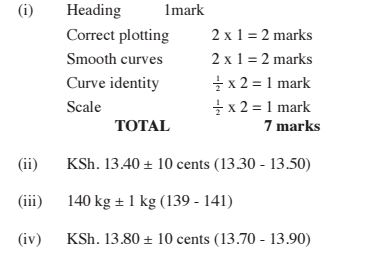
(b) (i) Seedbed preparation.
‘ Bush clearing.
‘ Carryout primary cultivation.
– Carrying out secondary cultivation.
‘ Prepare land early during the dry season.
‘ Deep ploughing to remove perenial weeds.
‘ Harrow to medium tilth.
‘ Carry out soil and water conservation measures.
4 x 1 = 4 marks
(ii) Planting of maize
‘ Plant at the onset of rains/dry plant.
‘ Space according to variety 75 – 90 cm X 20 – 30 cm.
– Plant one or two seeds per hole.
‘ Planting depth 2.5 – 10 cm depending on the moisture content.
‘ Plant manually or use planters.
‘ Use phosphatic fertilizer/organic manure at a ratio of 120 kg/ha.
3 x 1 = 3 marks
(iii) Harvesting maize
‘ Harvest after 3 – 9 months.
‘ Harvest When the Whole plant dries/harvest according to market demand.
‘ Harvest manually by hand or use combine harvesters.
‘ Cut and stook the maize if harvesting is manual.
‘ Remove the cobbed maize from the husks.
(3 marks)
4.15.2 Agriculture Paper 2 (443/2)
SECTION A (30 marks)
1 . Wool;
Meat;
2 x ½
2. Place salt on tongue;
Pour cold water on head and chest to activate the nerves;
Clear the mucus from the nostrils;
Hold upside down using hind legs and swing the calf.
Smack the ribs.
2 X ½
3. (a) One that requires two hosts to complete its life cycle.
(b) Red legged tick/Rhipicephalus everts;
Brown tick/Rhipicephalus bursa;
African bont-legged tick/Hyalomma truncatum;
The large bont-legged tick/Hyalomma rufipes;
2 x ½
4. High initial construction cost (high capital);
Dangerous for young and pregnant animals and the sick;
Requires a lot of water;
Poisoning by swallowed dip wash;
4 x ½
5. (a) (i) Cutting PVC pipes;
(ii) Wire strainer – to tighten wires during fencing;
(b) Cross-cut saw;
Spoke shave;
Wood rasp;
Mallet (to drive in wood and for hammering wood);
4 x ½
(c) (i) Canular
(ii) Bit
6. Vaginitis eg. Bovine Trichomoniasis.
Brucellosis (contagious abortion/Bang’s disease
Vibriosis
2 x 1/2
7. Acaricide resistance
High Cost of acaricide
Communal rearing practices
Lack of skills and knowledge in control of external parasite. Some are highly mobile/high mobility eg tsetse flies.
3 X ½
8.Long body
Black in colour
Drooping ears
Is hardy;
4 x ½
9.Chick mash;
Growers mash;
Layers mash;
Broiler staner;
Broiler follow-on;
Broiler finisher;
4 x ½
10.Injection
Oral (through the mouth)
Nasal (through nose)
Occular (through the eye)
cloacal
4 x ½
ll.(a) ECF/Theileriosis
Anaplasmosis/Gall stones
Coccidiosis
Trypanosomiasis/Nagana
Red Water/Babesiosis
3 x ½
(b) Fever
Starring coat
Discharges in the mouth and nose
Watery eyes/lacrimation
Diarrhoea and dysentry
Red mucal membranes With ulcers
Tooth grinding
Emaciation
Dullness
Loss of appetite/anorexia
4 x ½
12. Unblocking blocked nozzles
Replacing water in the tank
Tightening loose nuts/bolts
Repairing damaged floor
Sump should be cleaned regularly by removing all the sediments
Broken rails should be replaced
4 x ½
13. (a) Increase production
Protection against diseases
Reproduction
Maintenance
Increase quality of products.
4 x ½
(b) Cleaning feeders
Cleaning waterers
Provide fresh Water
Provide fresh feeds
Provide adequate waterers
Provide adequate feeders
Provide clean water
Provide clean feeds
4 x ½
14. Manage market weight
Determine birth weight
Determine growth rate
Manage feeding
Determine weaning stage
Determine mothering ability
4 x ½
SECTION B (20 marks)
15. (a) Fold/Ark;
(b) Wood;
Plastic;
Thatch;
2 x 1
(c) Labour intensive;
Accommodates few birds;
Results in dirty eggs;
Difficult to keep individual egg production records;
Breakage/damage due to frequent movement;
3 x 1
16. (a) Fascioliasis;
(b) Fasciola hepatica;
(c) Control the secondary host/snail;
Drenching using antihelmintics;
Burning pastures;
Avoid grazing in marshy areas;
2 X 1
(d) Damaged liver/organs;
Presence of the parasite;
Turnels of parasite movements;
2 x 1
17. (a) A New Zealand White/Kenya White;(l mark)
B California White;(l mark)
(b) Watering;(1 mark)
(c) Droppings and urine fall to keep the floor dry;(1 mark)
18. (a) Manganese(1 mark)
(b) (i) Reduced hatchability
(ii) Reduced shell thickness/ soft shelled eggs
(iii) Reduced appetite
(iv) Reduced growth rate
(v) Low production
(vi) Egg eating.
(vii) Loss of feathers(3 marks)
SECTION C (40 marks)
19. (a) Select a high grade pure breed bull; and a Well managed low grade heifer; Mate them to produce a heifer with half of the sire’s genes; Mate the heifer with a sire of the same pure breed as original sire; Subsequent; heifers should be mated with sires of the same pure breed as original sire; up to the sixth cross/generation; to produce a hygrade heifer with over 98% genes of the pure breed high grade bull;
or
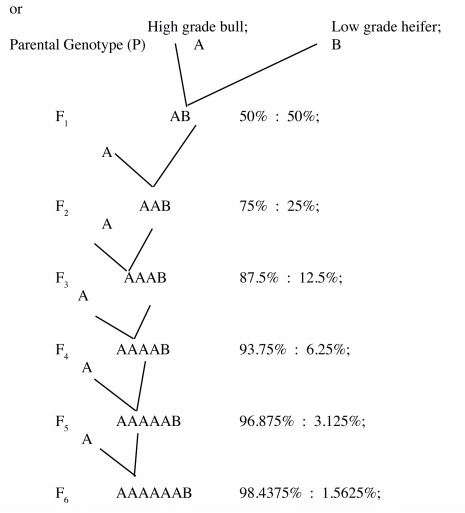
(8 marks)
(b) Overcrowded housing;
Fighting/pecking;
Lack of adequate clean water which impairs egg development;
Parasite infestation;
Inadequate feeding;
Old age;
Broodiness;
Inadequate Waterers/feeders;
Inferior feeds;
Egg eating;
Inadequate laying nests;
Presence of predators/strangers;
Sudden change of feeds;
Sudden noise;
Sudden change of weather to cold conditions;
Disease infection;
12 x 1 (12 marks)
20. (a) In the first week, the calf should be fed on colostrum ad libitum;
In the second and third weeks; it is fed on 3.5; and 4.0kg; of whole milk per day respectively;
From the fourth week; whole milk is gradually replaced with a mixture of whole and skim milk.
The milk should be at body temperature;
Calf pellets/pencils should be introduced gradually from the third week;
Green fodder should be gradually introduced from the third week;
milk should be divided initially into three equal parts and finally into two equal parts;
The amount of whole milk fed should be reduced as the calf grows;
Skim milk should be increased as whole milk reduces;
From the 7″‘ week the calf is not fed on whole milk;
Concentrates should be increased as the calf copes with bulky solid feeds;
At the 16″‘ week the calf can be fully introduced to forage crops;
12 x 1 (12 marks)
(b) Liming the pond;
Inlet channel or pipe should be opened so that fresh water fills the pond slowly;
Add manure or fertiliser to encourage growth of planktons;
Fish is introduced after about 2- 4 Weeks when planktons and other water plants have grown;
Fingerlings are obtained from recognised hatcheries; and transported with care in a water medium; using a plastic container at about 10 degrees celcius;
The fingerlings are then introduced to the water during the day when the water temperature is almost the same as that of the container they were transported in;
Lower the container into the pond and let it stay for sometime for acclimatisation;
Allow the fingerlings to swim out of the container;
Stock at an average rate of 5-10 fingerlings for Sm”
Feed the fingerlings;
8 x 1 (8 marks)
24. (a) (i) The engine should be checked daily by use of dip stick and oil level maintained;
The fuel level should be checked at the start of everyday’s work and added if necessary;
Water level in the radiator should be inspected and if low topped up;
The level of electrolyte should be checked daily and topped up with distilled water if low;
The nuts and bolts should be tightened every day;
Grease should be applied regularly to the moving parts;
Large sediments from the sediment bowl should be removed;
Tyre pressure should be checked every morning before the day‘s work and adjusted accordingly;
The fan-belt tension should be checked to ensure that it deflects between 1.9 cm – 2.5 cm when pushed;
The brake shaft bearing should be greased and break fluid level maintained;
Lost bolts and nuts are replaced.
10 x 1 (10 marks)
(ii) Moving parts should be oiled/ greased regularly to reduce friction (tear and wear);
The yoke should be properly maintained eg. repair when worn out, replaced if not repairable, properly padded;
Tyre pressure should be checked daily before the start of work;
Broken trailer bodies should be repaired;
Loose nuts and bolts should be tightened;
Paint it if to be stored for long to avoid rusting;
Clean after use;
Store under shed;
Replace lost nuts and bolts;
5 x 1 (5 marks)
(b) By checking the appetite and feeding – if low or excessive it indicates that the goat is sick
Defaecation – inconsistency in texture, colour, smell, frequency and posture, presence of arasite segments, egg, larvae or blood
Urination – irregular posture, colour and and frequency;
Change in temperature above or below the normal range;
Respiratory rate – irregular respiration shown by non-rhythmic inspiration and expiration indicates ill health.
Pulse rate – Abnormal pulse rate under normal physiological status indicates ill- health.
Production level – Loss of weight, emaciation and reduced production rate. Abnormal discharges
Posture – while standing or lying.
Behaviour eg. abnormal sound, aggression, excitement.
Appearance – eg. dullness, restlessness, pot belly, bloated.
Movement eg. gait, eg, standing or limping when walking.
Mucuors membranes (abnormal) eg. bright red colour, yellowish, blueish depending on disease.
Skin/animal coat – (abnormal) starring hair, coat, sores/wounds on skin. 5 x 1 (5 marks)
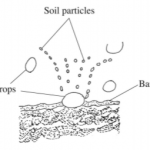
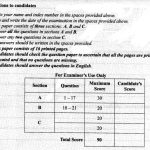
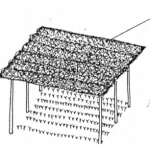


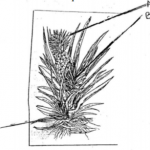
Thanks